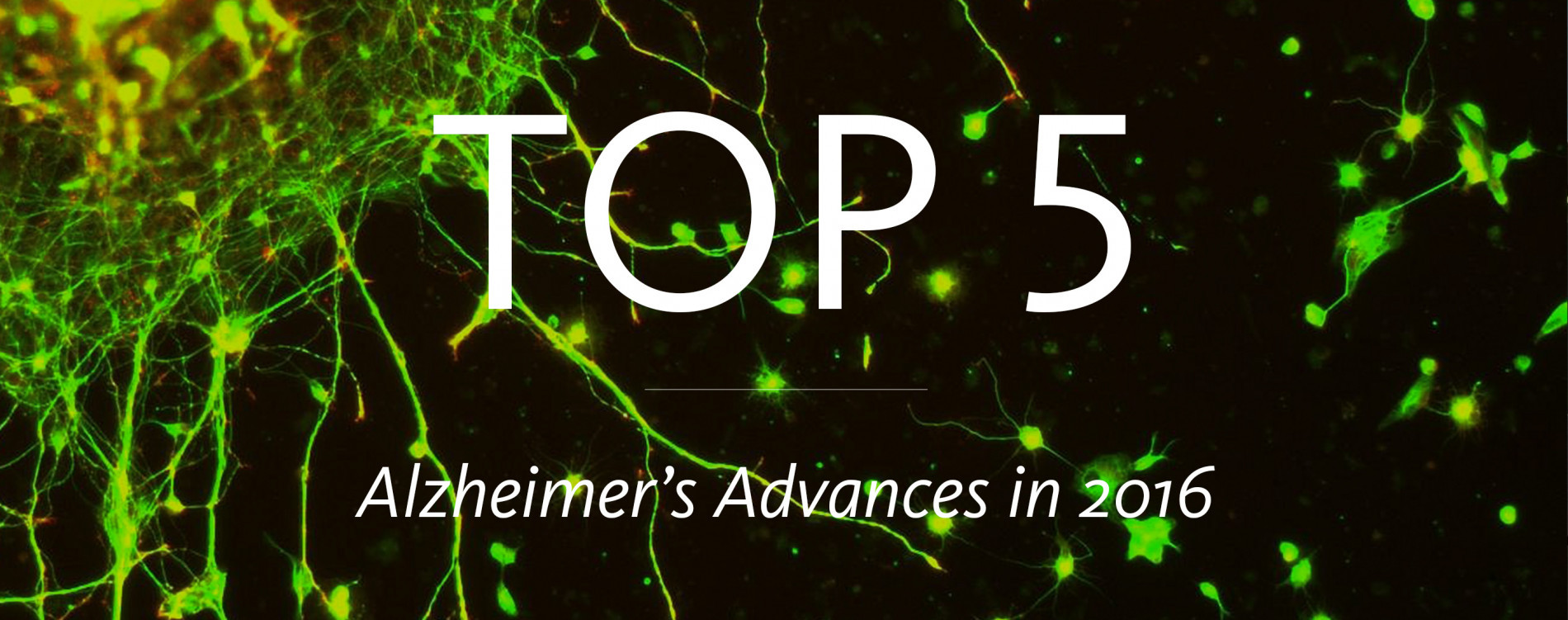In 2016, the Alzheimer’s Drug Discovery Foundation made 46 new grants totaling $16.3 million. This brought us to an important milestone—$100 million invested in drugs to prevent, treat, and ultimately cure Alzheimer’s. And we are closing in on a cure. Over the past year, we made great progress, as our top five advances demonstrate.
1. Despite Failures, New Treatments Are on the Horizon
This year, several Alzheimer’s drugs in phase 3 trials failed, including Eli Lilly’s drug solanezumab and TauRx’s LMTM. These results were disappointing, but many promising drugs are still advancing. There are more than 120 treatments for Alzheimer’s in clinical trials, and over 20% of those have received support from the ADDF. While most Alzheimer’s drugs in phase 3 trials target beta-amyloid plaques, the ADDF is funding more diverse drug targets, such as inflammation and neuroprotection. We believe that Alzheimer’s is a complex disease and requires a multi-faceted approach to effectively treat it. In 2016, we invested in 9 treatments in clinical trials, including Tetra Discovery Partners’ preparation for its phase 2 study of BPN14770. And in 2017, we will ensure that even more diverse treatments reach clinical trials, because the ADDF is committed to getting effective drugs to patients.
2. Evidence Grows for Inflammation as a Critical Drug Target
The ADDF believes that aging is the leading risk factor for Alzheimer’s. As we age, our inflammatory response increases. New findings reported in 2016 added to the evidence that increases in inflammation were associated with a faster pace of cognitive decline in people with Alzheimer’s disease. We also know that inflammation in the brain damages and destroys neurons, contributing to Alzheimer’s. The ADDF was an early funder of drugs targeting inflammation, and today it’s the second largest area of our portfolio. Our funded researchers are developing new drugs to combat neuroinflammation and repurposing approved drugs that target systemic inflammation in other diseases. Several have already reached clinical trials, including etanercept, being tested by Dr. Clive Holmes at the University of Southampton in the UK in a phase 2 trial. And in Boston, Dr. Phillip Haydon and his colleagues at the biotech Gliacure completed a successful phase 1 trial of GC021109. In 2017, we expect other drugs targeting inflammation to enter clinical trials, including an exciting program from Cleveland Clinic spin-off NeuroTherapia.
3. Epigenetics Breaks Through
One of the newest targets being explored to treat Alzheimer’s is epigenetics. Epigenetic treatments harness our body’s ability to alter how and how much our genes work. Think of it like a dimmer switch: you can turn genes on and off and also increase or decrease their intensity. In 2016, the first epigenetic treatment for any neurodegenerative disease entered clinical trials. Developed by Oryzon Genomics in Barcelona, the drug called ORY-2001 successfully completed a phase 1 trial and will enter phase 2 in 2017. It’s also being tested as a potential treatment for multiple sclerosis. Breakthroughs are happening in diagnostics, too. A PET scan being developed with ADDF support by Dr. Jacob Hooker at Massachusetts General Hospital allowed us to see epigenetic changes in the brain for the first time. This will help researchers determine if their treatments affect the brain as intended and has implications far beyond Alzheimer’s. Thanks to the progress made in 2016, epigenetic treatments are on track to become a reality in our lifetime.
4. New Diagnostic Tools Are on the Way
Dr. Hooker’s PET scan is one of many new diagnostic tools for Alzheimer’s and related dementias in development. ADDF-funded Dr. Neil Vasdev at Massachusetts General Hospital is working on PET imaging for tau, the brain protein that forms the “tangles” common in Alzheimer’s disease. Researchers at Lawson Health Research Institute supported by the ADDF are attempting to use perfusion MRI to differentiate types of frontotemporal dementia. And others are developing MRI contrast agents to better visualize beta-amyloid plaques and vascular cognitive impairment. Lower-cost tools are also in the works, such as blood tests and mass spectrometry of cerebrospinal fluid. These advances will have huge impacts. Though Alzheimer’s remains the most common cause of dementia, we know that some people diagnosed with it have other disorders. Accurately diagnosing patients will result in earlier and better treatment and ensure that clinical trials enroll the right patients.
5. New Evidence for Prevention
Perhaps the most exciting findings in 2016 were in dementia prevention. We learned that the prevalence of dementia is declining, thanks in part to better management of risk factors such as diabetes and hypertension and higher educational attainment. The ACTIVE study, the largest trial of “brain training” methods ever conducted, became the first to show that a specific brain training game can reduce your odds of developing dementia. And new findings added to the evidence that diets rich in DHA can improve brain health. Overall, the findings suggest that we can delay dementia and slow cognitive aging, which is good news. Last year, the ADDF’s relaunched CognitiveVitality.org, which provides information on ways to promote the health of your brain. On the site, our neuroscientists review all of the available research and provide clear, unbiased ratings on options to improve brain health and potentially prevent dementia. The ADDF’s mission is to prevent and treat Alzheimer’s and related dementias, and we are proud of the improvements we made to this important prevention resource.
